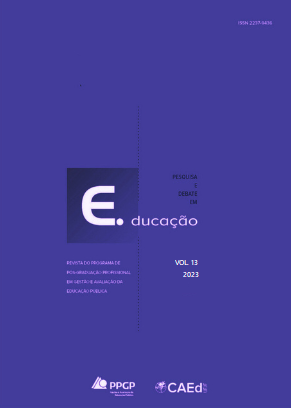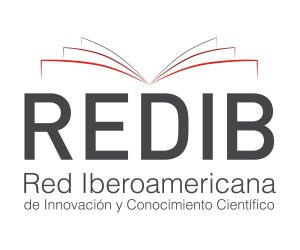Itens digitais no contexto de avaliações em larga escala
DOI:
https://doi.org/10.34019/2237-9444.2023.v13.40259Palavras-chave:
Itens aprimorados por tecnologias, Itens digitais, Formato de itens digitais, Avaliação em larga escalaResumo
O artigo apresenta uma revisão sistemática e bibliométrica com o objetivo de identificar e apresentar características, formatos e métodos para o desenvolvimento de itens digitais no contexto de avaliações em larga escala. Para tanto, é detalhado o processo de seleção e análise dos textos a partir de duas bases de dados no período de 2000 a 2021. Os resultados mostram pontos comuns que pautam a concordância sobre a influência do avanço tecnológico para a transição das avaliações do impresso para o digital e o surgimento de novos formatos de itens com diferentes características. Ademais, trazem críticas às organizações quanto à adaptação dos itens usados em avaliações impressas para a avaliação digital sem a clara compreensão de suas diferenças e a crença de que o digital por si só agrega valor.
Downloads
Referências
ARSLAN, Burcu; JIANG, Yang; KEEHNER, Madeleine; GONG, Tao; KATZ, Irvin R.; YAN, Fred. The Effect of Drag‐and‐Drop Item Features on Test‐Taker Performance and Response Strategies. Educational measurement: issues and practice, v. 39, n. 2, p. 96-106, 2020. Disponível em: https://onlinelibrary.wiley.com/doi/abs/10.1111/emip.12326. Acesso em: 12 ago. 2021.
BENNETT, Randy Elliot. On the meaning of constructed response. In BENNETT, Randy Elliot; WARD, W.C. (Eds.) Construction versus choice in cognitive measurement: issues in constructed response, performance testing, and portfolio assessment. Hillsdale, NJ: Lawrence Erlbaum Associates. 1993. p. 1-27.
BOYLE, Andrew, HUTCHINSON, Dougal. Sophisticated tasks in e-assessment: what are they and what are their benefits? Assessment & evaluation in higher education, v. 34 n. 3, p. 305- 319, 2009.
BRAUN, Tibor; GLÄNZEL, Wolfgang; SCHUBERT, Andras. A Hirsch-type index for journals. Scientometrics, v. 69, n. 22, p. 169-173, 2006. Disponível em: https://www.researchgate.net/publication/220365396_A_Hirsch-type_index_for_journals. Acesso em: 20 out. 2021.
BRYANT, William. Developing a Strategy for Using Technology-Enhanced Items in Large-Scale Standardized Tests. Practical assessment, research, and evaluation, v. 22, 2017.
BRUNO, Adriana Rocha. Relatório de atividades de pesquisa em avaliação 2018-2019/outubro. CAEd, 2019
BURGA LEON, Andrés Alberto. Aplicaciones de la tecnología a la evaluación psicométrica. Propós. represent. [online], v.7, p. 318-318, 2019. Disponívem em: http://www.scielo.org.pe/scielo.php?script=sci_arttext&pid=S2307-79992019000400006&lng=es&nrm=iso. Acesso em: 20 jul. 2021.
CRABTREE, Ashleigh. R. Psychometric properties of technology-enhanced item formats: An evaluation of construct validity and technical characteristics. 2016. Doctoral dissertation, 181 The University of Iowa. The University of Iowa’s Institutional Repository. Disponível em: https://iro.uiowa.edu/esploro/outputs/doctoral/Psychometric-properties-of-technology-enhanced-item-formats/9983777220902771. Acesso em: 30 jul. 2021.
FALAGAS, Matthew E.; KOURANOS, Vasilios D.; ARENCIBIA-JORGE, Ricardo; KARAGEORGOPOULOS, Drosos E. Comparison of SCImago journal rank indicator with journal impact factor. The FASEB journal, v. 22, n. 8, p. 2623-2628, 2008.
GIBSON, James J. The ecological approach to visual perception. Boston, MA: Houghton-Mifflin. 1979.
HALADYNA, Thomas; RODRIGUEZ, Michael. Developing and validating Test Items. New York, NY: Routledge. 2013. Disponível em: https://www.researchgate.net/publication/346346355_Developing_and_Validating_Test_Items. Acesso em: 25 jul 2021.
HEI, Qiwei, BORGONOVI, Francesca; PACCAGNELLA, Marco. Using process data to understand adults’ problem-solving behaviour in the Programme for the International Assessment of Adult Competencies (PIAAC): Identifying generalised patterns across multiple tasks with sequence mining. OECD education working papers, OECD Publishing, Paris, n. 205, 2019. Disponível em: https://www.oecd-ilibrary.org/education/using-process-data-to-understand-adults-problem-solving-behaviour-in-the-programme-for-the-international-assessment-of-adult-competencies-piaac_650918f2-en. Acesso em: 30 jul. 2021.
HUFF, Kristen L.; SIRECI, Stephen G. Validity issues in computer-based testing. Educational measurement: issues and practice, v. 20, n. 3, p. 16-25, 2001. Disponível em: https://www.researchgate.net/publication/229806166_Validity_Issues_in_Computer-Based_Testing. Acesso em: 30 jul. 2021.
JIANG, Yang; GONG, Tao; SALDIVIA, Luis E.; CAYTON-HODGES, Gabrielle; AGARD, Christopher. Using process data to understand problem-solving strategies and processes for drag-and-drop items in a large-scale mathematics assessment. Large-scale assessments in education, v. 9, n. 2, 2021. Disponível em: https://largescaleassessmentsineducation.springeropen.com/articles/10.1186/s40536-021-00095-4#citeas. Acesso em: 20 jul. 2021.
JODOIN, Michael G. Measurement Efficiency of Innovative Item Formats in Computer-Based Testing. Journal of educational measurement, v. 40, n. 1, p. 1-15, 2003. Disponível em: http://www.jstor.org/stable/1435051. Acesso em: 20 dez. 2021.
KANE, M. Content-related validity evidence in test development. In: DOWNING, Steven M.; HALADYNA, Thomas M. (Eds.) Handbook of test development. Mahwah, New Jersey: Lawrence Erlbaum Associates, 2006. p. 131-154.
KITCHENHAM, Barbara. Procedures for performing systematic reviews. Keele university, v. 33, p. 1-26, 2004.
KOCH, D.A. Testing goes graphical. Journal of interactive instruction development, v. 5, p. 14-21, 1993.
MACMILLAN, Neil A.; CREELMAN, C. Douglas. Detection theory: A user’s guide. New York, NY: Cambridge University Press. 1991. Disponível em: https://psycnet.apa.org/record/1991-97801-000. Acesso em: 30 jul. 2021.
MONCALEANO, Sebastian. Examining the comparative measurement value of technology-enhanced Items. 2021. 261 p. PhD thesis. Boston College Lynch School. 2021. Disponível em: https://dlib.bc.edu/islandora/object/bc-ir:109086. Acesso em: 20 jul. 2021.
MOON, Jung A.; KEEHNER, Madeleine; KATZ, Irvin R. Test takers response tendencies in alternative item formats: a cognitive science approach. educational assessment, v. 25, n. 3, p. 236-250, 2020. Disponível em: https://www.tandfonline.com/doi/abs/10.1080/10627197.2020.1804350. Acesso em: 20 jul. 2021.
MUCKLE, Timothy J. Web-based item development and banking. V In: LANE, Suzanne; RAYMOND, Mark R.; HALADYNA, Thomas M. (org.). Handbook of test development. 2. ed. New York, NY: Routledge, 2016. p. 241-258.
PARSHALL, Cynthia G.; DAVEY, Tim; PASHLEY, Peter J. Innovative item types for computerized testing. In LINDEN, Wim J. van der; GLAS, Cees A.W. (Eds.), Computerized adaptive testing: theory and practice. Kluwer Academic Publishers. 2000. p. 129-148.
PARSHALL, Cynthia G.; HARMES, J. Christine. Improving the quality of innovative item types: Four tasks for design and development. Journal of applied testing technology, v. 10, n. 1, p. 1-20, 2014.
PARSHALL, Cynthia G.; HARMES, J. Christine; DAVEY, Tim; PASHLEY, Peter J. Innovative items for computerized testing. In LINDEN, Wim J. van der; GLAS, Cees A.W. (Eds.) Computerized adaptive testing: theory and practice. 2. ed. Norwell, MA: Kluwer Academic Publishers. 2010. Disponível em: https://link.springer.com/chapter/10.1007/978-0-387-85461-8_11. Acesso em: 21 dez. 2021.
PARSHALL, Cynthia G.; STEWART, Rob; RITTER, Judy. Innovations: Sound, graphics, and alternative response modes. [Paper Presentation]. National council on measurement in education annual meeting, New York, EUA. 1996. Disponível em: https://files.eric.ed.gov/fulltext/ED421524.pdf. Acesso em: 22 jul. 2021.
PAULA, Samantha; ARAÚJO, Marco Antônio; SILVA, Júlio César da. Pesquisa científica baseada em uma revisão sistemática da literatura. RECM - Revista de educação, ciências e matemática, v. 6, n. 2. 2016. Disponível em http://publicacoes.unigranrio.edu.br/index.php/recm/article/view/4058. Acesso em: 20 dez. 2021.
QIAN, Hong, WOO, Ada; KIM, Doyoung. Exploring the psychometric properties of innovative items in computerized adaptive testing. In JIAO, Hong; LISSITZ, Robert W. (Eds.), Technology enhanced innovative assessment: development, modeling, and scoring from an interdisciplinary perspective. Information Age Publishing. 2017. p. 97-118.
RUSSELL, Michael. A Framework for Examining the Utility of Technology-Enhanced Items. Journal of applied testing technology, v. 17, n. 1, p. 20-32, 2016. Disponível em: http://jattjournal.net/index.php/atp/article/view/89189. Acesso em: 20 jul. 2021.
SAMPAIO, Rosana Ferreira; MANCINI, Marisa Cotta. Estudos de revisão sistemática: um guia para síntese criteriosa da evidência científica. Revista brasileira de fisioterapia, v. 11, p. 83-89, 2007.
SANTOS, Raimundo Nonato Macedo dos. Produção científica: por que medir? o que medir? Revista digital de biblioteconomia e ciência da informação, v. 1, n. 1, p. 22–38, 2003. Disponível em: https://brapci.inf.br/index.php/res/v/39961. Acesso em: 21 dez. 2021.
SCALISE, Kathleen; GIFFORD, Bernard. Computer-based assessment in E-learning: A framework for constructing “intermediate constraint” questions and tasks for technology platforms. The journal of technology, learning, and assessment, v. 4, n. 6, p. 1-43, 2006. Disponível em: https://ejournals.bc.edu/index.php/jtla/article/view/1653. Acesso em: 20 jul. 2021.
SCORTEGAGNA, Liamara. Relatório de atividades de pesquisa em avaliação 2020-2021/março. Juiz de Fora: CAEd, 2020.
SIRECI, Stephen G.; ZENISKY, April L. Innovative Item Formats in Computer-Based Testing: In Pursuit of Improved Construct Representation. In DOWNING, Steven M.; HALADYNA, Thomas M. (Eds.), Handbook of test development. Lawrence Erlbaum Associates Publishers, 2006. p. 329-347.
SIRECI, Stephen G.; ZENISKY, April L. Computerized innovative item formats: Achievement and Credentialing. In: LANE, Suzanne; RAYMOND, Mark R.; HALADYNA, Thomas M. (org.). Handbook of test development. 2. ed. New York, NY: Routledge, 2016. p. 313-334.
STRAIN-SEYMOUR, Ellen; WAY, Walter; DOLAN, Robert P. Strategies and processes for developing innovative items in large-scale assessments. 2009. Disponível em: https://www.researchgate.net/publication/349104257_Strategies_and_Processes_for_Developing_Innovative_Items_in_Large-Scale_Assessments. Acesso em: 30 jul. 2021.
TARRANT, Marie, KNIERIM, Aimee, HAYES, Sasha.K., WARE, James. The frequency of item writing flaws in multiple-choice. Nurse education today, v. 26, n. 8, p. 662-671, 2006. Disponível em: https://www.sciencedirect.com/science/article/abs/pii/S0260691706001067. Acesso em: 20 dez. 2021.
WAN, Lei; HENLY, George A. Measurement properties of two innovative item formats in a computer based test. Applied measurement in education, v. 25, n. 1, p. 58–78, 2012.
WISE, Steven L.; SOLAND, James; DUPRAY, Laurence M. The Impact of Technology-Enhanced Items on Test-Taker Disengagement. Journal of applied testing technology, v. 22, n.1, p. 28-36, 2021. Disponível em: https://eric.ed.gov/?id=EJ1296001. Acesso em: 20 jul. 2021.
ZENISKY, April L; SIRECI, Stephen G. Technological innovations in large‐scale assessment. Applied measurement in education, v.15, n. 4, p. 337-362, 2002. Disponível em: https://www.researchgate.net/publication/248580109_Technological_Innovations_in_Large-Scale_Assessment. Acesso em: 08 ago. 2021.






















